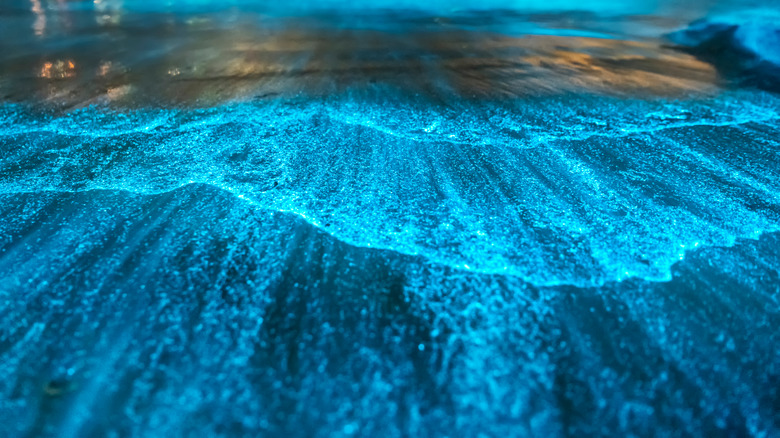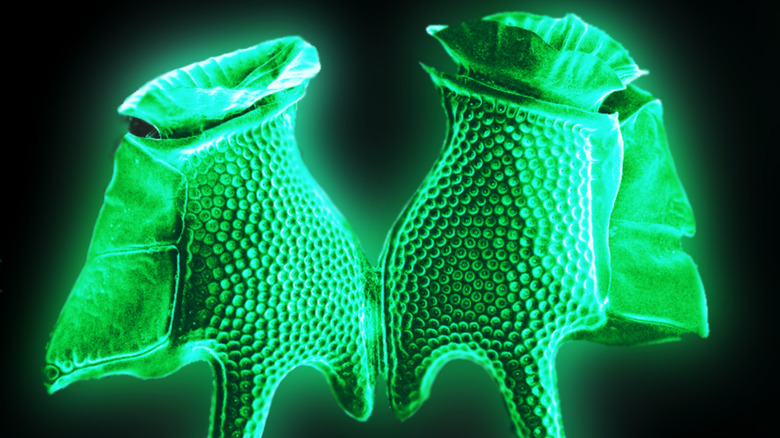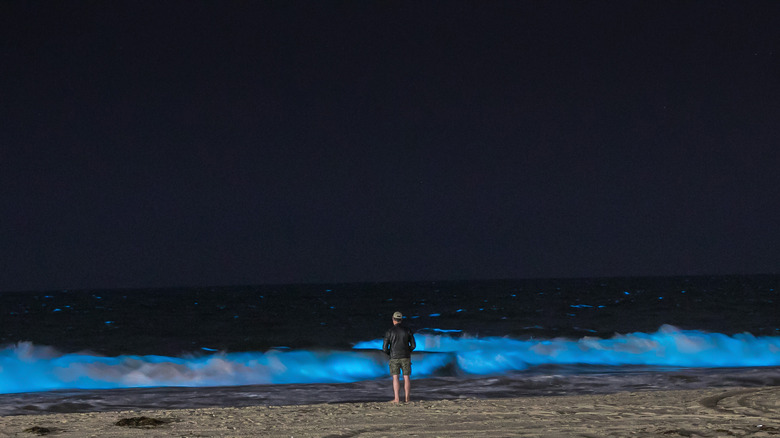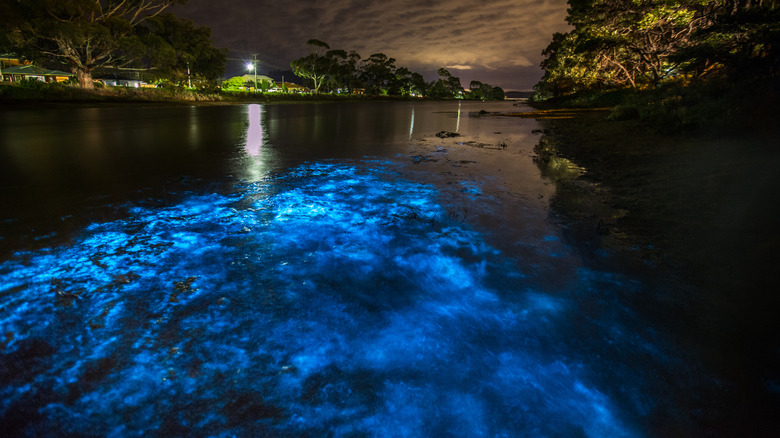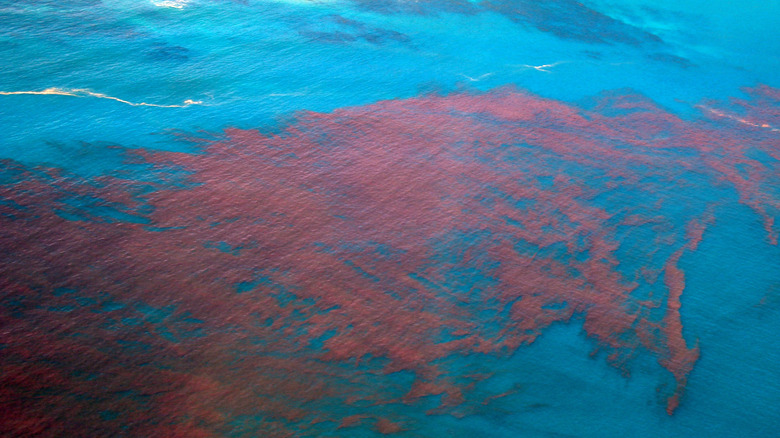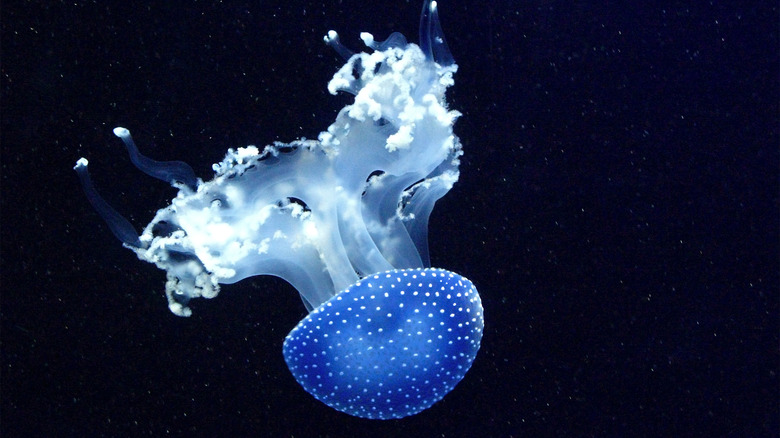The Surprising Reason Some Bodies Of Water Glow In The Dark
When the ocean's waves crash along the shore at night, we expect to perhaps be able to see the white of the wave's crest, but not much else in the darkness of the night sky. But every once in a while, photos of the world's oceans pop up on social media and look like something out of a Hayao Miyazaki movie, showing an entire coastline producing electric blue light and sparkling like the very stars in the night sky above.
We see the same image depicted in the "Life of Pi," where our young protagonist lights up the ocean with his movements while swimming in the sea (via Oyster). What happened in the "Life of Pi" is actually based on a real phenomenon, and it's the same thing causing our electric blue oceans to become social media stars. What's behind this strange otherworldly beach scene is a type of marine plankton called Noctiluca, or sea sparkle.
What is a noctiluca?
Noctiluca, a type of dinoflagellate more commonly known as bioluminescent plankton, is a tiny organism able to produce light within its body through a natural chemical reaction (per the Government of South Australia). That means these twinkling plankton experience a type of chemiluminescence, but they are officially named bioluminescent creatures because the chemical reaction occurs inside the body (via American Oceans). The result of this process is a unique glow that you've probably seen at some point.
Bioluminescent plankton become more abundant when algae blooms occur in the ocean. They can most clearly be observed in the deep sea, and it also helps if there is a new or near-new moon in the night sky to make their glow really pop in the darkness. At the same time, bioluminescent plankton are activated by movement, like waves cresting along the shore or your own limbs swimming in the ocean like Pi.
Why do they glow?
According to a study in Current Biology, we know at least one species of bioluminescent plankton — which are so microscopic that thousands of them can be squeezed into a single drop of water — uses its glowing powers to scare away copepod grazers that would typically eat them (via Science Daily). The study's findings are pretty remarkable, considering the light show produced by bioluminescent plankton is typically activated by movement. What the study showed was that, instead, the tiny creatures can activate their light themselves after sensing when copepods (the character of Plankton from Spongebob is based on them) are near.
Interestingly, bioluminescence is also considered a form of "cold light" versus "warm light" — meaning less than 20 percent of the light generated by bioluminescent plankton comes in the form of heat — and that is why oceans with these sea sparkles appear blue in nature. This supports the study's findings as well since most sea creatures can only distinguish between blue-green colors rather than reds, yellows, and violets (per National Geographic Society).
Where can you see them?
Bioluminescent plankton can be spotted in Hong Kong, Japan, Puerto Rico, Tasmania, Vietnam, Costa Rica, Australia, and more. Within the U.S., they've been known to occur in Florida, New Jersey, and San Diego (via Oyster). It's thought that the likelihood of spotting them is higher in the summer months because they are more common when ocean waters are warmer (via American Oceans). According to the National Geographic Society, dinoflagellates also tend to gather in lagoons or bays, where there is a small opening to the sea that keeps them gathered in a group.
Although it's hard to predict algae blooms — also called "red tides" because they turn the ocean red during the day — anywhere that has them can produce these sea sparkles at night. Red tides have been around since before human beings walked the earth, but it is thought that human activity has made them more prominent. For example, agricultural runoff and human waste that flows from cities into the ocean can make the algae bloom faster, making more red tides and more glowing seas (per SciJinks).
Is it dangerous?
Because bioluminescent plankton are so closely linked to red tide, it can be dangerous to get too close to them. Harmful algae blooms eventually die and begin to decompose in the ocean, which sucks out much of the oxygen from the surrounding water. As a result, other fish may not get the oxygen they need to survive and may die off. That's why during a red tide, you might see dead fish washed up along the shore more frequently (via SciJinks). They may also be accompanied by a fishy bad smell, and it can also be dangerous to eat fish or shellfish that have been in the water with toxic algae because the toxins they ingested can be passed down to you.
On the other hand, bioluminescence could be experimentally used to the benefit of humankind. Imagine if one day, for example, bioluminescent trees could light roads and sidewalks, reducing the need for electricity. And according to the National Geographic Society, if crops could use bioluminescence to alert farmers when they needed water or nutrients, agricultural waste could be reduced.
Are there other bioluminescent organisms?
Most bioluminescent species are found in the ocean, including fish, bacteria, sharks, and jellies, according to the National Geographic Society. Some bigger organisms don't actually produce light themselves but ingest smaller organisms like bioluminescent plankton and then proceed to glow. This is the case for the midshipman fish, a sort of toadfish that fits in your palm and eats glowing seed shrimp. Other organisms, like the squid, hold bioluminescent bacteria in organs specifically designed to produce light. The squid keeps the bacteria safe in its organs, while the bacteria allows the squid to glow to ward off predators in a symbiotic relationship.
There are also animals on land that are bioluminescent, like glowworms and fireflies. Most creatures on land or water use bioluminescence to hunt, defend themselves, or attract mates. One species of deep-sea squid, for example, squirts bioluminescent goo rather than ink to distract predators and escape. Another type of sea cucumber can actually detach and regrow its limbs so that it can shoot a bioluminescent limb onto another organism to confuse predators.
